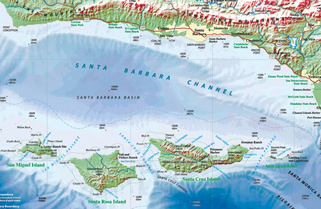|
about us
about us: santa barbara channel
|
The CA Channel Islands and their surrounding
waters offer a wondrous world of terrestrial and aquatic beauty.
Over 2,000 species of plants and animals live on the islands
- 145 of which are found nowhere else on Earth. The Channel's
waters host 27 types of whales, dolphins and porpoises, six
species of seals and sealions, and a myriad of both warm and
cold water fish. With such biodiversity, this area is protected
as a national treasure and is often referred to as "America's
Galapagos Islands."

Click on the image above for a larger
view
The
Santa Barbara Channel:
Prevailing northwest winds, the confluence of major oceanic
currents, and the shapes of nearby ocean basins and the
continental shelf support incredibly diverse and productive
biological communities within the Santa Barbara Channel.
Nutrient-rich water wells up from the deep-sea near Point
Conception, on the mainland coast to the north. As this
water drifts south in the bright southern California sunlight,
swirling around the islands, it produces rich food webs
including everything from microscopic plankton to blue whales.
Nutrients also well-up seasonally when strong northern winter
winds blow surface waters away from the southern shores
of the islands, drawing water from mile deep basins south
and west of the park. The cold, nutrient-rich, waters mix
with warm southern water to produce exceptionally productive
food webs and create a wide range temperature regimes.
Among
the more prominent ecosystems in the Channel, found both
along the coast and surrounding the islands, are forests
of giant kelp (Macrocystis pyrifera), which inhabit relatively
shallow rocky reefs. These submarine forests, reaching the
ocean surface from depths over 100 feet, provide food and
shelter for more than 125 fishes, and habitat for scores
of other animals and plants, nearly 1,000 species in all.
Eelgrass beds (Zostera marina) provide nursery habitat for
juvenile fishes, and elk kelp forests (Pelagophycus porra)
inhabit deeper water than the giant kelp. Vast sand plains
between the reefs host a variety of clams and other burrowing
organisms. The deeper reaches of the channel waters extend
down to 2,000 feet or more as they trail off into submarine
canyons. Many commercially important fish inhabit these
deeper waters and invertebrates, such as corals, sponges,
and feather stars, cover deep reefs below the reach of sunlight.
The Channel and its islands currently provides habitat for
breeding populations of four species of pinnipeds: the California
sea lion, the northern fur seal, the northern elephant seal,
and the harbor seal. Stellar sea lions and Guadalupe fur
seals are occasional visitors to the area. All six species
are found at different times of year, feeding on abundant
fish and invertebrate resources of the island shelves or
hauling out on rocks and beaches. At least 27 species of
whales and dolphins have been sighted in the sanctuary and
about 18 species are seen regularly and are considered "residents".
Little is known about the areas of concentration, life history
or behavior of the resident populations. The Channel is
also part of the migratory pathway of the California Gray
whale in the winter and spring and serves as the primary
summer feeding grounds for the gigantic Blue and gregarious
Humpback whales.
Over 60 species of marine birds may use the channel waters
to varying degrees as nesting and feeding habitat, for wintering,
and/or as migratory or staging areas. Of the 16 resident
species of marine birds in the southern California bight,
eleven breed in the channel. San Miguel Island supports
the most numerous and diverse avifauna, with nine species
having established colonies. Santa Barbara Island has several
nationally and internationally significant seabird nesting
areas, including the largest nesting Xantus' Murrelet colony
and the only nesting site in the United States of Black
Storm-Petrels. The Brown Pelican, an endangered species,
maintains its only permanent rookery in California on Anacapa
Island.
Because of the presence of this rich marine habitat the
Channel Islands National Marine Sanctuary was established
in 1980 and protects 1,658 square miles (4,311 square Km)
of water in and around Santa Barbara Island and the four
northern Channel Islands.
© 2002 All information above is from the Santa Barbara Channel Islands Poster published by Eric Zimmerman and EZ Photography/Solutions. Reproduction of this information without consent is prohibited. www.ezphotography.net
|



